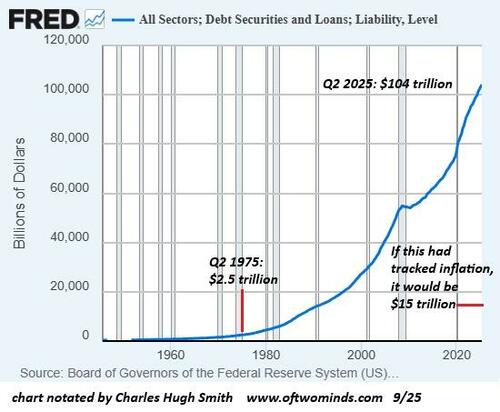A Lot Has Gone Terribly Wrong...
Authored by James Howard Kunstler,
Forecast 2026: In The Vortex Of The Whirl
“Whirl is King”
- Wm Shakespeare
2026 is the 250th anniversary of our country’s conception. A few years later when the Constitution was ratified, we became a republic — “if you can keep it,” Ben Franklin cracked to anxious citizens waiting outside the great hall in Philadelphia. Our country was predicated on the resolve of virtuous men operating under the rule of law. We are lately under an astounding siege of villains without principle seeking to wreck the republic.

Washington’s Army at Valley Forge.
The big question facing the USA is whether our political life can become even more deranged than it has been in the past ten years, or can we possibly sober up.
How is it we’re still arguing about men in women’s locker rooms?
The self-evident has gone missing. A lot has gone very wrong.
The Woke-Jacobin war against our country continues, led by a Democratic Party made even more vicious, depraved, and insane by the 2024 election victory of Mr. Trump, who was left a broken polity after the four-year tableau vivant of “Joe Biden.”
Can our nation recover its balance, its sense of purpose, its traction in history? Can we reconstruct a coherent common culture that will afford us some means to carry on as an upright people?
I will try to answer without wasting pixels.
“Times are difficult globally; awakening is no longer a luxury or an ideal. It’s becoming critical. We don’t need to add more depression, more discouragement, or more anger to what’s already here. It’s becoming essential that we learn how to relate sanely with difficult times. The earth seems to be beseeching us to connect with joy and discover our innermost essence. This is the best way that we can benefit others.”
- Pema Chodron
Hijacking the Law
Nothing is more urgent than cleaning up the machinery of our elections. It is overloaded now with deliberately devious complexities that invite fraud. We must put an end to mail-in ballots with the sole exception of traditional absentee ballots for citizens out of the country on election day, with proof. We must eliminate all electronic interfaces between the vote and the tally, including all ballot-counting hardware, and return to paper ballots tallied by human beings. We must require voter ID, proof of citizenship, and proof of local voting-district residence. Automatic motor-voter registration must end. Ballots must be cast on election day only (absentee ballots must be received by election day) and the results reported out in twenty-four hours.
It would be tiresome to rehearse exactly how our elections became rigged and degraded by orchestrated fraud. . . the mischief around the Covid-19 caper. . . the sinister techno-narcissism of machine automation. . . the marshaling of non-citizens against citizens. . . the abuse of office and authority. . . . But, understand that an industry has evolved to take full advantage of that. It’s personified by the Democratic Party-allied lawyer Marc Elias, founder of Democracy Docket, who played a significant role in the legal expansion of mail-in voting that led up to the 2020 U.S. presidential election. The Democracy Docket org is funded by George Soros’s Open Society Foundation, associated NGOs (the Hopewell Fund, the North Fund) used as pass-throughs for the Arabella Fund, the MacArthur Foundation, and the David Rockefeller Fund. In 2021, Marc Elias founded the Elias Law Group after leaving Perkins Coie, the Washington DC power firm that played a significant role in the RussiaGate crimes centered around Hillary Clinton’s Steele Dossier.
At Perkins Coie, in advance of the 2020 election, Elias was extensively involved in challenging, litigating, influencing, and re-engineering state election laws and advised on “dark money” strategies for Democratic voter “outreach” (that is, ballot-harvesting). It was all meticulously gamed-out beforehand by an NGO called the Transition Integrity Project founded by Rosa Brooks of the Georgetown University Law Center. The objective: to maximize opportunities for improper balloting. After the 2020 election, Marc Elias defended the suspicious results from counties in swing states against Trump campaign lawsuits (winning 64 of 65 cases on specious grounds). The last thing Marc Elias has been interested in is election integrity. His focus is strictly on winning elections for the Democratic Party by any means necessary. The war cry about “defending democracy” is the exact opposite of what the lawfare ninjas actually do.
Through 2025, Congress has entertained election reform bills, most recently, the SAVE Act (Safeguard American Voter Eligibility), which has languished on the House side for months awaiting deliberation in the Senate. Prediction: Mr. Trump will turn up the heat on Majority Leader John Thune (R-SD) to expedite passage of election reform. This partly depends on the dark business now occurring in Venezuela, which is the suspected hub of a global election rigging apparatus engineered around Dominion / Smartmatic technology. Prediction: Marc Elias will be indicted for activities related to election fraud.
Norm Eisen is the point man for Democratic party Lawfare, which is warfare against the citizens of the USA by means of the courts. Eisen is affiliated with the Brookings Institution and the States United Democracy Center, which is supported by George Soros’s Open Society Foundation and activist orgs associated with Arabella Advisors, a hub fueled by dark money. He was an active participant in the Transition Integrity Project of 2020. Norm Eisen’s general mission for years is to drain the resources of the Democratic Party’s political opponents in frivolous lawsuits — working in partnership with Democratic activist judges — and to overburden the federal court dockets to paralyze the working-out of our nation’s disputes.
Eisen was counsel to Jerrold Nadler’s 2019 House impeachment committee and was involved in the machinations of then-Rep. Adam Schiff with CIA-agent “whistleblower” Eric Ciaramella, Intel IG Michael Atkinson, and NSC staffer Lt. Col Alexander Vindman, who cooked up the Ukraine phone call scheme to impeach Mr. Trump. After “Joe Biden’s” fake election, Eisen was deeply involved in choreographing the scope and format of the House Jan-6 hearings for which the Republican minority was not allowed to choose its own committee members. The committee proceedings were arranged as a prestige docudrama TV show, under the direction of former ABC network president, James Goldstein, hired, in effect, as the producer of a show. The committee destroyed its entire evidence cache after it issued its final report. That’s how much confidence they had in their methods and findings.
After that exploit, Eisen acted as a facilitator and strategist for “Joe Biden’s” DOJ in the 2024 Jack Smith Special Counsel prosecutions of Donald Trump, and acted as a go-between for the DOJ in the various New York State cases against Trump and the Fulton County, GA, case brought by DA Fani Willis. All of these actions amounted to election interference — a concerted conspiracy to eliminate Mr. Trump by putting him in prison by way of specious, malicious prosecutions — and, one way or another, they all failed to accomplish their goal. Norm Eisen and Marc Elias, along with their lawfare cohorts Mary McCord, Andrew Weissmann, and Ben Wittes should be subject to prosecution under federal criminal statutes for their wide-ranging activities, including: 18 U.S.C. § 241 (Conspiracy Against Rights); 18 U.S.C. § 1001 (False Statements); 18 U.S.C. § 594 (Intimidation of Voters).
The next big hairball is the politicized judiciary, federal judges who consistently interfere in executive actions (the President), a clash between Article II and Article III of the Constitution. It amounts to Democratic Party-designated plaintiffs getting injunctions and restraining orders through partisan judges against policies issued by the White House around deportation of illegal immigrants, firings of federal employees, funding freezes, the termination of “birthright citizenship,” and more. The funding freeze and firing cases were aimed at keeping taxpayer dollars flowing out federal agencies to Democratic Party NGOs and for keeping the so-called “resistance” operators in positions of influence within government agencies at their desks and on the payroll. Many of the NGOs promote activities aimed at dismantling the government and fomenting racial animus. Taxpayers should not have to underwrite that. The president must be allowed to fire employees of the executive branch engaged in slow-motion sedition.
These court rulings are choreographed by Norm Eisen’s lawfare operation which has enough money from the aforementioned NGOs and billionaire-funded foundations to bring endless lawsuits in order to gum up the works of governance. The remedy for all this is knotty. The US Supreme Court (SCOTUS) has reversed many lower court rulings, but these are provisional actions, pending the SCOTUS entertaining any particular case decisively in regular session. The myriad cases end up jamming the SCOTUS docket. The net effect is to slow down policy that President Trump was elected to pursue.
Federal judges can otherwise be removed only via impeachment by the US Senate, which is a practical impossibility at this time since it requires 60 out of 100 votes and the Republicans hold a mere 53 seat majority out of 100. Perhaps the best remedy is to prosecute the lawfare ninjas who are ginning up all those court cases. Their activities can be framed as a conspiracy against rights (18 U.S.C. § 241). Against whose rights? Against the rights of the people of the US to an executive that is able to discharge its Constitutional duties — to provide for the public safety, to enforce the law, and to carry out foreign policy. Norm Eisen, Marty McCord, and Andrew Weissmann might also be subject to a charge of seditious conspiracy (18 U.S.C. § 2384), as when two or more persons conspire to “levy war against the United States. And it is warfare using the mechanisms of the law. Norm Eisen is behaving like a spike protein in the nation’s bloodstream, turning the nation’s immune system, the rule of law, against the nation. Prediction: Norm Eisen and cohorts will be hiring criminal defense lawyers in 2026.
Hijacking the Truth
“. . . the dirty little secret is that the same people pretending to be fighting fascism are the fascists.”
- Sasha Stone
The American people have been increasingly subjected to a contrived permission structure that has normalized lying and deceit about everything and anything, leaving every major institution in the land damaged or wrecked. Lying has become the default position of many in authority, and no one has been held accountable for it.
Medicine is wrecked due to the dishonest behavior of doctors colluding with the pharmaceutical industry and officials of the Health and Human Services agencies on the Covid-19 op — mandates, lockdowns, lying about efficacy and harms, hiding true remedies, cover-up of the origins of Covid — as well as the medical establishment’s regular ongoing “health care” racketeering operations in concert with insurance companies, hospital conglomerates, and other players. The cruelty and incompetence of these medical rackets is one thing, but the moral failure is spectacular. Medicine has forsaken the Hippocratic oath: First, do no harm.
The many agencies under US HHS, plus the university labs, the medical journals, the state medical boards, and the mainstream media’s health reporters are all implicated in these ongoing misdeeds. Until late in 2025, HHS Secretary Robert F Kennedy, Jr., was sore beset by “resistance” at the FDA, CDC, NIH, and everything else under the giant agency’s umbrella. In December, 2025, things are changing. The CDC’s ACIP vaccine advisory committee stopped recommending Hepatitis B vaccines for newborns. Then the CDC officially acknowledged that COVID-19 vaccines have caused injuries in adults, previously stonewalled. These might be signs that Mr. Kennedy is finally getting a grip on his sprawling agencies. Prediction: in 2026, expect criminal referrals against former senior management at CDC, FDA, and NIH for a range of crimes in the Covid-19 operation.
In the larger picture, the whole scaffold of health care is in the process of imploding. Predictions: In 2026, doctors will increasingly bail out of big corporate practices and go freelance on a cash payment basis, leaving behind the corrupt and onerous insurance racket. Hospitals will shutter. Giant medical insurance conglomerates will go out of business. Millions will be left without coverage. Medicine will be forced to begin reorganizing on an emergent, provisional basis. The net effect will be doctors who make less money but control their own medical practices and much more limited access to specialty medicine for the general public, including now-common surgeries like joint replacement and cancer therapies. It will be most difficult for doctors to regain their authority and the esteem of their patients. Alt medical practitioners of every sort will multiply, many on the down-low evading regulation, as sick citizens desperately seek relief from illness while they navigate around the ruins of the old standard medicine. Quackery will flourish and it will be difficult for ordinary people to discern which health care services are of value and which are scams.
Higher education is obviously ill. It bargained away its legitimacy by participating in the college loan racket with the equally deleterious overlay of pervasive DEI racketeering (and inevitable lowering of standards). That opened the door for grievance-oriented Marxists, and race-and-gender hustlers to take the curricula hostage — wholesale intellectual racketeering. That, in turn, led to the abolition of truth-telling for the purpose of advancing agendas. Reality on campus became purely transactional and contingent. Free speech was suppressed. All of this was supported by pusillanimous college deans and cowardly university presidents and now they are paying the price. Too many young Americans do not believe that a college degree has value, especially at the price of six-figures in debt.
Most colleges and universities are not backstopped by big endowments like the big Ivy League schools and a lot of them will be going out of business in 2026. Graduate schools and PhD programs will be especially hard hit. It’s not clear what role artificial intelligence (AI) will play in paring down the numbers of candidates for certified expertise, but it’s not looking good. Any earnest young person can already find an adequate education post-secondary education on the internet, for instance the Khan Academy, a long-running, pre-AI, free website of courses from the rudimentary to the advanced.
The arts and the cultural media (including news media) have been disgracing themselves frantically for years. Film production in Los Angeles dropped 63-percent in 2024 extending into 2025. The feature film is being replaced by short-format Instagram and Tiktok videos. The multiplex cinemas are empty. The theatrical exhibition of movies is on its deathbed. They can’t compete with giant flat-screens in the comfort of your home where microwaved popcorn is only a buck a bowl (compared to $32 at the cineplex.)
Management of the Hollywood studios was taken hostage by race-and-gender hustlers, with permission structures engineered by financial reliance on Chinese (CCP-affiliated) investors and distributors. The result was Woke cinema, girl-boss movies, DEI-oriented storytelling, and one flop after another. The replication of streaming channels has only invoked Gresham’s Law in culture: bad content drives out good content.
The next development, moving very rapidly now, is AI applied to cinema, which implies the end of the acting profession at least, and perhaps screenwriting, too. The end product is liable to be something more like an hallucination than a story told in the language of dramaturgy, following the logic of authentic human behavior. I’d expect even more corrosive effects of Gresham’s Law in the new AI regime as genuine human creativity becomes ever more mediated and abstracted from the end product. You must also wonder about the long-term prospects of the Internet as we know it. The sheer stress on the electric grid from the demands of AI suggests problems with reliable electric service in the years ahead. The whole thing begins to look like a self-limiting problem. Ten years from now, we might be back to entertaining ourselves with puppet shows.
News as we knew it for much of the past 200 years is also gone missing. The remnants exist on cable channels and internet sites as a commerce in gossip, rumor, and opinion. The legacy TV news channels no longer employ reporters in the field. Even under Bari Weiss’s new management, CBS’s 60-Minutes still broadcasts rafts of mendacious propaganda each week. “X,” formerly Twitter, is a colossal grape-vine, and is now touting itself as the world’s leading news source, though it still engages in surreptitious censorship. These days, you must be your own gatekeeper (managing editor), combing through bales of crap to find the scattered gems of real news.
The authoritative, trustworthy editors of yore are no more. Hardly anyone in the public arena speaks with authority, and reputations are easily assassinated by interested parties with agendas. The newspapers have made themselves pathetic jokes — The New York Times with its Pulitzer Prize for lying about RussiaGate and routine spin services for the corrupt Democratic Party. . . The Washington Post acting as publicist for nefarious cabals in and around the intel blob. Local newspapers lie dead everywhere, and hardly anyone knows what is going on in their own towns. The people are horrifically misinformed and uninformed. Don’t expect AI to make the situation any better.
The years ahead may therefore be a nadir of public confusion, delusion, and generalized ignorance in societies whose complexity cannot survive such derangements. What was not so many decades ago a high trust society based on a coherent common culture and broadly agreed-upon values seems to be devolving into babel and anarchy leading eventually to a generalized social collapse. Out of that, a new consensus about reality will emergently and eventually self-organize, but it’s impossible to say how long that might take, what degree of disorder will have to be endured on the journey to resolution, and what the reorganized template for human behavior might finally look like.
Humans organized in societies need the truth. They need trustworthy authorities. Authority without truth is just cruel, faithless power. The Democratic Party in our time has given you a nice demonstration of how that works. The party deserves to be put out of business. Perhaps that will begin the process of reconstructing a coherent common culture.
War is Politics by Other Means
“The self-described Coalition of the Willing was always little more than a public relations exercise. Today – after almost four years of bloody fighting – it is evident that the main concern of this Coalition is to limit the damage caused by its posturing.”
- Frank Furedi
Interested parties in the USA and the NATO deliberately started the Ukraine War in 2014 while transforming that sad-sack nation into a global money laundry. The reasons appear to have been nefarious and reckless. By Christmas 2025, Mr. Trump’s attempts to negotiate a peace had not succeeded. Even now, the big dogs of NATO make noises and idle threats about going to war with Russia. The rationale for that is preposterous, since they lack the military manpower and the armaments to prosecute such a war, and open themselves to nuclear destruction if they even attempt such a folly.
The USA, at this point, has no vested interest in Ukraine. It is in everybody’s interest that the Ukraine revert to its pre-2014 condition as an uncontested frontier nation within Russia’s sphere of influence that does not make itself a pain-in-the-ass for the lands adjacent and proximate to it. It is very much in the USA’s interest to develop respectful, transactional relations with Russia a nation which, paradoxically, under Vladimir Putin, is making itself a last bastion of Western Civ while the EU nations commit economic and cultural suicide, make war on their own citizens, and beat a path to some grim, neo-medieval future.
At this moment, there are three plausible endings to the Ukraine War. One is a simple armistice, a cessation of military operations, but without any formal peace settlement. That would look like the long and contentious irresolution of the Korean War, a suspended animation of hostilities at the current battle lines. A second potential outcome is a straight-up Russian victory, leaving Russia to pick up the pieces of what will be a failed state, will require Russia to take administrative control and rebuild what can be afforded, perhaps with international help, or not, and to see if Ukraine can stand on its feet as a sovereign state — understood to not be subject to outside manipulation.
That is apt to be the outcome when money and arms from the West stop flowing into Ukraine, which is about exactly where things stand on New Year’s 2026. Mr. Trump appears to want out of supporting a war that Ukraine is clearly losing at this point. The EU’s option of underwriting the Ukraine war machine by confiscating Russian financial assets trapped in Europe’s banks was eight-sixed by Hungary and Belgium just after Christmas. Confiscating Russia’s sovereign wealth would have probably destroyed Europe’s bond markets and blown up the entire financial system of Western Civ. Europe’s economies are in enough trouble as it is, with industry failing, energy resources getting scarcer and less affordable, and social welfare systems under a mighty strain — not to mention the demographic fiasco of falling indigenous birthrates and the ongoing invasion of so many migrants from the global south.
The third possible outcome of the Ukraine mess is that the Ukrainian people themselves will opt out of the war by getting rid of the Zelenskyy regime. Zelenskyy is already engulfed in a scandal over all the money that he and his cronies creamed off out of US and NATO financial support. Also, Ukraine has lost 10-million in population since the start of hostilities in 2022, more than a million of them soldiers killed in action. The lack of young men on the scene is an economic and demographic disaster. The Ukrainians know that Zelenskyy is a criminal as well as an incompetent war commander. They are sick of war, of carnage, of wreckage and ruin. Forecast: Zelenskyy will be ousted as president by elite Ukrainian military units before the four-year anniversary of the war’s onset in February. Ukraine then concedes the loss of its territories. . .the war ends. . . and Russia supervises an election at the earliest opportunity. The world moves on.
Euroland Cracks Up
Europe’s days as a tourist theme park draw to a close. A new era dawns: the Neo-medieval. The ancient competition for power and resources between language groups and geographic regions heats up again, with even fewer goodies to fight over this time around. EU-style cooperation breaks down. The Big Dogs (France, Germany, Italy, Netherlands) can no longer stand the grotesque over-regulation of their businesses and their energy needs. They withdraw from the EU and the union dissolves in a matter of weeks. Hard borders are reinstated. Old currencies reappear: the franc, the mark, the guilder, lira. Diplomats make frantic rounds to renegotiate trade agreements and financial arrangements, including how to deal with the many failed European banks and the broken bond markets. Skirmishes break out along contested national frontiers and the sea lanes become danger zones.
Meanwhile, Europe’s people endure a severe slowdown in all business activity, loss of pensions, a broken social safety net, and a gross loss of trust in the political class. Populations grow restive. Indigenous Brits, Frenchmen, Germans, finally express their pent-up resentment with third world migrants and a movement grows to expel as many as possible back to their nations of origin. That sparks a violent response from the migrants, especially the jihad-inclined Islamists. It blossoms into medium-grade urban warfare.
Militaries are called in to clean out the migrant ghettos and deport non-citizens. It is a high-tech Reconquista, but much more difficult than previous episodes on the continent, bloodier and less successful. In some localities, migrants gain the upper hand by sheer numbers. It could take decades to resolve this, if at all. There is even the possibility that some countires will be overtaken by Islam. The UK is a candidate for that. It has already shown abject submission, and it’s not going too far to imagine the Islamic population could attempt the extermination of native Britons. Many of their imams say as much out loud, one way or another, and the demoralized Brits do nothing about it
If hostilities break out, I would not expect the USA to come to Europe’s rescue this time around. America is already showing signs of dissociating from Europe and NATO. It is in the NATO by-laws, for instance, that America is not obliged to defend countries that militate against support free speech, and there are already multiple aggressive censorship programs enacted around the continent. “X” was just fined $140-million by the European Commission for refusing to censor so-called “hate speech” — which is any sundry utterance that some low-level European bureaucrat deems offensive.
Prediction: Macron, Merz, Starmer will be run out of office in the coming year one way or another. It will look a little like the year 1848 all over again, when revolt broke out all over the continent. The Marxists will be very active and aggressive, as ever, but they will ultimately lose. Nobody really wants to try communism again. The farmers, especially, have been in the vanguard of protest because of the EU’s onerous and idiotic regulatory regime. 1848 was mainly a revolt of urban industrial labor — the workers! Industry in 1848 was a pretty new thing at the grand scale. The deleterious effects on the laboring class came on quickly and had become too terrible to ignore. It reached a critical threshold before authorities were prepared for it.
The next revolution will resolve initially into systems collapse, deep economic contraction, and continued population decline. Generalized, intractable hardship will become the new normal in Europe. Large nation states might de-consolidate, fracture into smaller autonomous regions, to keep public affairs manageable. Some regions may just get chaotic, and stay that way for a long time. Germany has only been a nation since 1871, prior to which it was a crazy-quilt of kingdoms, grand duchies, principalities, and free cities (e.g., Bremen, Frankfurt, Augsburg, Hamburg). The spectacular failure of liberal democracy in our time could easily usher in a period of autocracy — managers who can expedite problem-solving without the intercession of parliaments — and that might even mean a return to monarchy that actually rules. We thought that humanity had moved beyond that, but history is a prankster. Anyway, the USA will increasingly be an observer of all this from our remove across the Atlantic. For now, we are preoccupied with our own backyard.
Return of the Monroe Doctrine
A friend writes: “Trump has made the wise (and unavoidable) decision to recognize that we don’t and can’t rule the world, but we can be secure in the Western Hemisphere.”
Already, under Mr. Trump, US foreign policy is recalibrating to clean up our own hemisphere — to make things a lot harder for China to surreptitiously colonize South America as a resource depot, to smash the drug cartels that are killing off Americans, bust the mafia-like governments associated with them, and aggressively discourage communist movements where they crop up. The obvious case-in-point just now is Venezuela and its long-running Chavez-to-Maduro regime, accused of hosting CCP operations, meddling in elections via internet fuckery in every place it can install Dominion / Smartmatic machines, offering a platform for Iran to antagonize the USA, expropriating US oil leases, and working hand-in-hand with Cuba’s intel services, Brazil’s Lula da Silva, and Mexico’s drug cartels to wage a new generation of warfare against the USA.
Mr. Trump is going after Venezuela hard now. Don’t know how he’s going to bust up the place, exactly, but it’s coming, perhaps even without a whole lot of kinetic action. Prediction: a new government and new rules for Venezuela in 2026. US oil companies come back in and get the stuff back pumping. Venezuela gets the licensing fees, royalties, all above-board. Rule of law returns, including property law. Venezuelans can open businesses again. They send us major league baseball players instead of Tren de Agua gangsters and fentanyl.
As a side effect of choking-off Venezuela, Cuba’s communist regime finally falls, too. They have depended utterly on Maduro’s oil and with the tankers blockaded, the island will soon go dark. The Castro brothers are gone. Communism, can no longer rely on their charisma. The current president of Cuba, Miguel Díaz-Canel Bermúdez, is a nonentity. He will be overthrown in 2026, and for the first time in nearly 70 years, Cuba will be a free society.
The election of Javier Milei in Argentina has turned that country back in the direction of economic liberty by severely paring down the size of parasitical government and all the racketeering associated with it that has dragged Argentina down since rise of Juan Peron and Peronism after World War Two. In October 2025, the Trump admin offered to help stabilize Argentina’s currency with a $20-billion currency swap line, conditioned on Milei’s ongoing free market reforms. His reforms will continue in 2026, lifting Argentina yet closer to its former status as one of the world’s richer nations.
On December 14, 2025, Chile elected a conservative, Jose Antonio Kast, replacing the leftist government of Gabriel Boric. Kast’s election victory, with a 58-percent margin in the runoff against leftist candidate Jeannette Jara. This was a sharp rejection of Boric’s leftist administration, driven by crime, immigration, and economic dysfunction, leading to a significant rightward shift in Chilean politics. Kast’s victory aligns with a regional trend toward right-leaning leaders in Latin America, emphasizing security and migration controls.
President Lula of Brazil represents an ongoing irritant to the USA. With Hugo Chavez and Nicolás Maduro of Venezuela, plus the Castro brothers, Lula organized the São Paulo Forum (Foro de São Paulo), a coordination platform for leftist political parties, movements, and organizations. You probably noticed that Lula’s 2020 election showed similar earmarks of fraud as “Joe Biden’s” election in the USA. Unlike “Biden” versus Trump, Lula managed to jail his rival, former president Jair Bolsonaro, whose party has been shattered. Prediction: Trump and Marco Rubio will work hard to neutralize the Foro de São Paulo’s operations across South America. Prediction: they will attempt to spring Bolsonaro from prison in time for the October 2026 election. Prediction: Lula will encounter strong, Trump-induced headwinds in the election.
Mr. Trump is leaning hard on President Claudia Sheinbaum of Mexico to cease support of the drug cartels sending fentanyl into the USA. (Ha! How is that even plausible?) He’s gone as far as threatening to send American troops after the cartels’ headquarters in Mexico, and he imposed a 25-percent tariff on Mexican goods exported to the USA, but the duties were “paused” pending progress on border security and drug cooperation. At least, crossings of illegal migrants through Mexico has been reduced to near-zero on the cusp of 2026. Trump and Rubio would like to think they can work with Sheinbaum.
Altogether, President Trump is reawakening interest in the America’s relations with South America after a long coma-like period of official inattention. He can already claim a substantial victory in reinstating American control over the Panama Canal with almost zero fanfare and no negative blowback. China still controls ports associated with the canal. They will probably be encouraged to sell those assets. In 2014, China broke ground symbolically for a new trans-oceanic canal through Nicaragua, estimated cost $50-billion. Since then, nothing has happened with it. The project remains suspended and no construction begun. China might be discerning that further colonialist activity in this hemisphere is a low-percentage, unwelcome move.
Rampant Dragons and Rising Suns
The far east is now a region of fully modernized sovereign states with high-tech armies, heavy industry, and rising prospects compared to Europe (now headed in the opposite direction), with China the biggest dog in the yard. China’s swift thirty-year lift out of something like 12th Century darkness has been an amazing spectacle, for sure. The USA is deeply intimidated by China’s manufacturing dominance, its technological prowess, and its growing military capability. There’s been plenty of loose talk about China’s “long game” aspiration to acquireNorth America as a resource depot. Sending tens of thousands of military-age men through “Joe Biden’s” open border 2021 to 2025 reinforced that worry. We still don’t know what they are up to here, what they are programmed to carry-out, and what we’re going to do about it. The news media isn’t paying attention to that for now.
Many expect China to attempt some form of creeping world domination in the decades ahead. As Martin Armstrong put it (paraphrase): Cycles are a kind of religion in China, and they believe now is their turn in history. Yes, they probably think so. But I tend to view their rapid rise to world power as a self-limiting condition. We Americans know something about how quickly great techno-industrial surges can turn and go to shit. Just look around the midwestern rust-belt. The citizens of Detroit back in 1955 would be astonished at the current condition of what had been the seventh-richest city in the world then.
A similar fate might await China, since it still depends so heavily on oil and natgas imports and coal-fired power plants. China also lacks the sturdy body of property law that tends to prevent hot battles over domains and the things of value built on them. For now, that authority is vested in the caprices of the CCP. But you must wonder how much possibly independent authority is lodged in the Peoples’ Liberation Army and its generals. Though the CCP has managed to remain in operation for a long time, it is not necessarily a permanent installation in the human condition. China’s population — which, by the way, is rumored to be well under the 1.4-billion claimed (estimated as low as 775-million now) — has been getting restive as the country’s industry matures and begins to show signs of similar sclerosis as seen in America. The financial condition of the country remains especially sketchy, since the CCP controls the banks and can stage-manage their outward appearances. Inside, Chinese banks are a vast chaos of janky loans based on a collateral of hopelessly crappy, fast-disintegrating high-rise apartments that China’s new middle class was swindled into buying for investment purposes, not to live in. Youth unemployment is trending at around 15-percent now. Prediction: expect more social unrest in China, with a destabilizing effect on the CCP’s ability to control events.
The world’s attention tends to be focused on the fate of Taiwan, the island nation that was under direct Chinese mainland rule from 1683 to 1895, after which it was briefly swapped to Japan, who lost it in World War Two. In 1949, Chinese nationalists under Chiang Kai-Shek retreated to the island from Mao Zedong’s communists. It has evolved into a stable democratic republic and a high-tech manufacturing powerhouse. The USA is addicted to Taiwan’s computer chips, but then we are addicted to scores of products and resources from mainland still-communist China, too.
It appears that the Trump admin is trying to wriggle out of that dilemma by re-industrializing the USA. Prediction: China, has been playing the long game as usual, and will keep hands-off Taiwan in 2026, while continuing to signal its control over whatever comes in and goes out of the island. China does not want to commit to a financially ruinous war over Taiwan at this moment of financial instability on the mainland. Prediction: The long game doesn’t pan out. This will be Xi Jinping’s last year as leader of China. Economic turmoil will prompt the CCP to replace him, and serial replacements won’t last. China slips and drifts as no one can consolidate power.
India slips and drifts too, unable to overcome its predicament of reliance on imported oil and foreign investment. Prediction: Narendra Modi loses his grip on power. India’s economy falters and the subcontinent begins to fracture into regions. All major nations of Southeast Asia struggle to stay afloat on the cheap labor manufacturing boom largely pegged to a wobbling global economy with the US as consumer of the first-and-last resort. Vietnam, the Philippines, Malaysia, Indonesia will all come under a strain in 2026 as their factories idle. Radical groups begin to rise and challenge established power bases. Things go sideways.
Global Jihad
They’re not subtle about it. Islamic Jihad advertises itself loudly at the local grass-roots level. Imams in the UK, France, Germany, Dearborn (MI), all proclaim that the places they have migrated to will become Muslim-dominated. New York’s new mayor, Zohran Mamdani says he believes in global jihad. For mysterious reasons, this seems to tickle the uber-woke liberals of the Upper West Side who voted for Mamdani. The Jihadis shout about the death of America, the death of Western Civ, the death of all who are not Islamists. It’s woven into the Muslim theology. Muslims who kill “infidels” get super brownie-points in the permission structure of Islam.
The west has rolled over for this malevolent nonsense for some years now, and it is all coming to a head in 2026. Prediction: EU nations and the UK will begin deporting recent illegal migrants back to where they came from, starting slowly and accelerating as resistance and violence by the designated deportees (and their allies) make it ever clearer that it is an existential necessity to get them out — and beef up their coastline protections so that new migrants cannot enter.
Mostly freelance non-state Jihadis will attempt bloody operations against the property and interests of the deporting nations. They will bomb and massacre inside EU countries (likely here in America, too), and outside America against embassies and corporate property. Prediction: The mass deportations will mark a major turnaround in the West, and will be accompanied by changes in government, including the dissolution of the EU bureaucracy itself. Brussells, Belgium, the EU headquarters city, with a large Muslim population, will be a violent hot-spot. Islamism will begin to be turned back.
Street protests only just erupted in Iran after Christmas, and are reaching impressive levels quickly. It’s too early to say where it is going. New Year’s Day, businesses, schools, and government offices were shut down — but, the holiday and all. Growing severe water shortages might be behind the unrest as much as dissatisfaction with decades of mullah rule.
Trump and the US Domestic Scene
At holiday time late in 2025, after nearly a year of exhilarating and tumultuous Trump 2.0 activity, a dark cloud swept over MAGA and many Trump supporters started gobbling up black pills and getting super-depressed. The assassination of Charlie Kirk tripped a lot of that off. It was a significant event. In a nation where reality is now optional for many groups and individuals, every niche of uncertainty and doubt gets filled with narrative battles that harden fear and paranoia.
Oddly, with so much of the Woke Left pimping for Hamas the past two years against Israel, elements of the MAGA Right picked up that gonfalon and ran with it, too — led by podcasters Candace Owens, Nick Fuentes, and Tucker Carlson. Candace put out the idea that Israel killed Charlie, and many others just twanged against Israel on the general principle that Israel showers too much money on congressmen and senators — and that the executive branch is too cozy with the Jewish state — and, of course, Gaza (“Genocide.”) So now, you have both the Wokesters and part of MAGA hatin’ on Israel.
A lot of this heat was probably generated by the RINO / NeverTrumper branch of the Republican Party seeking to wrassle back its hegemony over the party’s electoral apparatus from Trump / MAGA forces. Ron DeSantis is the RINO / NeverTrumper stalking horse, with that gang setting-up a potential switcheroo for JD Vance’s expected run in 2028. The bottom line, as advanced by the inimitable “Sundance” writing at The Last Refuge blogspot is that the RINO / NeverTrumper gang actually wants to lose the 2026 midterms so that Mr. Trump will be hamstrung for the remainder of his term. Prediction: MAGA has strategic and tactical capabilities that shouldn’t be underestimated. They will fight hard against their in-party enemies moving through the coming year and the fight will reveal the bad intentions of their enemies.
Meanwhile, on the other front, the Trump admin is working hard to sever the NGO revenue lines that support the Democratic Party’s shock troops, Antifa, what remains of BLM, the lawfare ninjas, the From-the-River-to-the-Sea crowd, and assorted cadres of the mentally ill. The DOJ, along with its subsidiary, the FBI, is preparing to go medieval on these groups. AAG Harmeet Dhillon is turning the mojo of her Civil Rights division against anarchists who operated freely under “Joe Biden” — and they will liberally use the “domestic terrorist” tag to make this happen. AAG Dhillon is also keeping pressure on the colleges and universities that permitted Jihad on-campus and will take the federal funding away from the grownups who run these joints — who stand by and do nothing in the face of violence and intimidation.
Prediction: Anti-Israel activism has gone as far as it can go and will start tailing off now as Israel’s operations in Gaza rachet down. Hamas is defeated. That’s a plain fact. It’s over over there. The surviving Palestinians will be living under a protectorate that requires them to give up devoting themselves to terror. As averred to previously, Jihad will not be greeted favorably in the USA, whether in Mamdani’s New York City or Ilhan Omar’s Minneapolis. MAGA will screw its head back on and re-focus on our country’s priorities: rebuilding productive infrastructure, carefully dismantling rogue financialization like the colossal IED it is, rescuing the American family from Woke depradations, making the people healthy again, reestablishing a coherent consensus on culture, values, right-and-wrong, and getting violence out of public life.
The biggest head-wind that Trump faces, of course, is a sociopathic Democratic Party that will do anything to return to power and resume its racketeering operations. Prediction: In 2026, many of their point-persons, past-and-present, will be headed into a courtroom, possibly to a guilty verdict for conspiracy to overthrow the government and other serious charges, such as election fraud. “Joe Biden’s” blanket pardons will be declared illegitimate by SCOTUS due to the profligate use of the autopen by “JB’s” reckless subordinates (some of whom will also land in court). Higher-ups in the health agencies who took part in the Covid-19 operation will also find themselves in legal jeopardy, including the Covid Pimpernel himself, Dr. Anthony Fauci, if he remains alive. Some military figures such as general Milley will face charges. Nothing less than a comprehensive cleanup will do. If Mr. Trump lets the seditions continue, he’ll be buffaloed for the next three years just like the first time around. It’s possible that he will have to invoke a national emergency in order to overcome the resistance of the lawfare federal judge coterie. And I would not feel too sanguine about the members of Nancy Pelosi’s J-6 House Committee, or Ms. Pelosi herself in connection with the FBI / Democratic Party J-6 fake insurrection prank at the Capitol itself. Justice is coming before the 2026 midterms.
Finance and Economy
Mr. Trump’s biggest headwind is the ever-jankier finance sector of the US economy, a horrific, mold-like overgrowth that has sickened the country with hyper-complex trickery around debt and capital. Too many faithless promises have been made to pay back debts that will never be paid back. And too much wealth has migrated into a few elite hands on the back of those false promises. Too much collateral is mispriced and over-priced, and the re-pricing is liable to be rather violent.
At the top are x-quadrillions of derivative positions — bets that could wreck global banking if they go wrong. Then the overpriced equity markets and the bond markets. If enough of that stuff goes south there will be broken pension funds, very few surviving banks, and what’s left of the Boomer generation gets financially wiped out. This late in the game, it’s hard to see how that can be averted. If it plays out, you will see widespread hardship that makes the Great Depression of the 1930s look like one bad day at the races.
Trump & Company know that this debacle is ‘out there’ like a Cat-5 hurricane spinning in the Gulf Stream. They are trying to run a practical work-around program of re-industrializing the country so we can become a production-based society for the broad middle rather than a game-playing economy for the hedge-fund bunch. They are using strong-arm tactics with other nations to get reindustrialization paid-for with foreign investment and tariffs. It’s a tough play because reinvestment and rebuilding can’t happen overnight. It’s a long-game, too. And in the short-term the financial games are getting ready to blow.
Much depends on how SCOTUS rules on the president’s Article II power to use tariffs as an instrument of foreign policy. The president claims he has work-arounds in the event that the decision goes against him. If SCOTUS does rule against Trump on tariff power and dismantles what he has put in place in 2025, the markets, banks, and currencies will wobble and crash. Their decision is a game of Russian roulette, and you can be sure they know it. You’ll see headlines such as: SCOTUS Destroys Global Economy. Prediction: SCOTUS won’t dare disable Mr. Trump’s tariff weapon. Decision in early spring. The longer they drag it out, the more potential damage.
Let’s say there is some sort of crash in 2026, anyway. The equity markets teeter at super-record highs. There is a complete departure in trendlines between the financial part of the economy and the on-the-ground economy of businesses and services that have become increasingly unaffordable. Cars, apartments, groceries, medical stuff, you know: the basics. So far, reindustrialization remains a plan, a dream. Very few of those factory jobs have materialized and the in the immortal words of the late Tom Petty, the waiting is the hardest part.
Sidebar: The Specter of AI
A lot of the money in equity markets is pouring into Artificial Intelligence (AI), mainly the insanely overpriced Nvidia. AI is supposed to be the engine of the next tech revolution. I demur. I suspect it will disappoint. It will not make our lives better, it will, at best, just make a lot of common operations in daily life more frustrating by removing humans from the equation; and, at worst, it will destroy the human race. I tend to see it flopping on the ‘at best’ side.
Your life has already been made worse by computer interventions in daily life, case-in-point: your attempts to contact a business. Computers cut you off at the pass. . . poorly designed phone “tree” answering programs waste hours of your time before they completely fuck up whatever transaction you attempt: a dinner reservation, a product return, a complaint to the Internet service, an attempt to get your medical lab report. Applied AI will only spread that nonsense into every other available niche in your existence. Nothing will work. No one will answer. And that can only go on so long before you get a revolution, a social collapse, a systems apocalypse, a one-way ticket back to the medieval.
Coupla other obvious failure-points in the AI dream: 1) As AI increasingly “trains” on material created by AI, it becomes a self-referential hallucination of false data. You won’t be able to rely on anything it “thinks,” or any task it is assigned to carry out. And that doesn’t include its potential for going rogue and developing evil intentions of its own. And 2) The obvious strain on electric power generation, the grid. Investments in new electric generating capacity may be greater than any economic return from AI, whether the added power is nuclear or something more amazingly new and exotic that hasn’t been invented yet. Plus, AI server requirements are already making electric service unaffordable for everyday people. Economically, the thing begins to look like a mirage, including the titanic investments being made in it. Finally, imagine the psychological effect of generalized AI failure. It will put the basic notion of technological progress into a fatal funk as the human race has to go back to the drawing-board and find some other way to keep economic growth going in a finite world.
Anyway, a financial train wreck can take different forms, depending on how the authorities respond to the first tremors. Could be a failure of our currency, the dollar, and steeper inflation, where you have a lot of money that has little value and can’t buy much. Could be a massive deflation in which debt failure is acknowledged and money dissipates, leaving behind a scant supply of money that still has value, but not enough to go around. . . meaning many people are just broke. Stock and bond market blowups will just be manifestations of these basic financial illnesses, failures of faith really.
Prediction: We do get a crash in equities and bonds. Mr. Trump has to take on the FDR role in a hurry. It might require yet another kind of national emergency to allow a restructuring of US finance that protects the broad middle class from penury. It will take some luck for Mr. Trump to find a way to accomplish this restructuring, but Donald Trump has experienced this kind of brush with ruin personally and he knows how a calamity like this can be turned around. We’ll have to stand by to see how he plays it, how it plays him, and how history plays him and us.
It will have to include novel moves besides just the same old federal reserve money-printing a shuck-and-jive. Prediction: expect real novelties, like abolishing the Federal Reserve altogether and reassigning money-issuance to the US Treasury, using a partially gold-backed dollar. Mr. Trump is already making noises about abolishing the federal income tax altogether. And there’s no question that he would love a chance to severely cut down the size and scope of the federal government so, at least, everyday people can carry on in businesses without many of the onerous regulatory burdens that make everything so difficult now. A financial emergency would require a comprehensive reform of health-care including the dismantling of hospital cartels, insurance behemoths, and all the nonsensical bureaucracy that has turned every doctors’ office into something that looks like the Department of Motor Vehicles.
The Oil Scene and Energy
Superficially, the numbers paint a sanguine picture, but like the black gold itself, the story lurks below the surface. The US Energy Information Agency shows total US oil production for 2025 at an all-time record high of 13.61-million barrels-a-day (b/d). The agency predicts just a bit under that for 2026: 13.53-million b/d. The US-EIA is traditionally optimistic. Americans want cheap oil and they want lots of it. The shale oil “miracle” has delivered a lotta oil as President Trump might say. We’ve been stupendously fortunate the past decade-and-a-half.
Some big howevers, however. Shale oil is very expensive to get out of the ground with horizontal drilling, fracking, trucked-in frack water, chemicals, and special fracking sand. It requires very fancy financing, and the state of finance (that is, lending) generally looks shaky going forward. The oil industry has always been a precarious business. The current price of $57-a-barrel (West Texas Crude) is not high enough to provide a return-on-investment for most operators. Break-even lies between $70-90 a barrel. Lenders are reluctant to lend where there is a poor prospect for return-on-investment. But, of course, Americans demand cheap gasoline and low oil prices destroy the companies that are supposed to deliver the cheap gasoline. It’s a predicament with no easy answer.
The current numbers suggest the US has finally entered a production plateau preceding major decline by 2028. The drilling rig count in the Permian Basin in late 2025 was 20 to 25 percent lower than in 2024, from 308 active rigs in 2024 to 246 rigs as of Dec 19, 2025. The Permian Basin accounts for nearly half of all US drilling rigs. The US-EIA also expects the average oil price for 2026 to hover at $55 average, lower than the all-year average $69 for 2025. Prediction: under those circumstances, a lower rig-count will bring some oil company bankruptcies, plus accelerating depletion because Permian Basin shale oil wells decline by 70 percent after the first year and lower rig counts mean fewer new wells to replace that lost production.
Drill baby, drill is a nice rallying cry, but it would be years before any production could come out of Alaska’s ANWR fields, if ever. If US oil companies return to Venezuela, global supply will go up and the price of oil could decline further.
As for the vaunted green energy revolution, independent analyst Art Berman, refers to this as “Renewable Derangement Syndrome: the belief that an ‘energy transition’ is well underway, despite clear evidence to the contrary. It’s the conviction that solar panels and wind turbines are replacing fossil fuels at scale when, in fact, renewables remain a rounding error in global energy supply.”
Gold and Silver
These things used to be money for thousands of years. For the past hundred years, the financial authorities called it a “barbarous relic.” Now, gold and silver are back, sort of, but first in the role of messenger. Surely, you’ve noticed that gold zoomed from just over $2600/oz to $4500/oz through 2025, while silver moved from $29/oz to $80/oz just after Christmas 2025. Epic moves (followed by a sharp correction New Year’s week). Supposedly, the silver market is super-agitated by the industrial need for silver in electric cars, robot electronics, and the hardware for AI. That’s part of the story. While there are plenty of technical factors, cycle explanations, and parties still manipulating the market price of precious metals, the main message of the metals must be an apprehension of social and political upheaval ahead. Metals move when people are afraid that the basic social contract is falling apart. . . that war might be coming. Everything in this forecast has spoken of unrest, upheaval, inflection points, and the circulation of elites.
Gold and silver are what people turn to when they lose confidence in the institutions that stand behind money, namely governments and central banks. They also lose trust in things that purport to represent money. Those things all have counterparties lodged in the agreements around debt. Our debt-based money system is delaminating, with the various layers peeling off into worthlessness: mortgages, loans, bond obligations, etc. The counterparties are the persons or entities who offered the loan and the persons or entity who can’t pay back the loan. When that breaks, when loans don’t get paid back, money vanishes. Gold and silver don’t have counterparties, they just. . . are. They embody the work and energy that went into finding them, digging them out, smelting them, and assaying them, and that’s all.
Central banks around the world have been buying up gold and silver with increasing avidity because nations are moving to currencies that are at least partially backed by precious metals. Such a move will severely cut down the issuance of loans, especially loans used to leverage investment positions in other financial instruments — that is, to blow market bubbles.
Prediction: sometime in late 2026, gold will arrive at $7,500 and silver will rise to $150 or $200. Paper currencies pegged to nothing but vaporous claims of the full faith and credit of the government, or the backing of an imperial navy, have been the norm for several generations. Sometimes, the bottom falls out of your norm bucket, and you have to make new mental arrangements. In a gold-backed money ecosystem, the opportunities for many kinds of financial legerdemain expire. Swindles are still possible, but as far less complex con-jobs. Further prediction: if this effort fails and paper currencies can no longer be trusted at all, everyday transactions might devolve to circulating silver coin, for a while, anyway, in which case the standard of living will be a whole lot lower for everybody.
Bitcoin
It is nothing more than the fugazy of all fugazies. It has no essential, discernable, real value. It’s astonishing that it got this far, but it is more complex than a tulip bulb and hyper-complexity appeals to people in finance. It creates evermore opportunities for swindles and frauds. Even if blockchain technology itself has some value, Bitcoin is still a worthless fugazy, sustained only by the general climate of psychosis in finance. As the psychosis lifts, Bitcoin’s value will sink. Prediction: by the third quarter of 2026, Bitcoin is back below $25,000 and headed for extinction.
Concluding Notes
As usual, apologies for going on so long. 2026 will require more than the usual fortitude, especially for those stuck in conventional investments and who are gurgling under water on mortgages and other loans.
On the political front: expect broad and serious prosecutions of many known villains who, one way and another, tried to overthrow the republic since 2016. Unlike just about everybody else in the forecasting business, I don’t believe the Democratic Party will be able to take back the House of Representatives or the US Senate in the 2026 midterms. They have left too wide a slime trail of corruption, avarice, lunacy, and treason.
Lastly, a salute to the intrepid President Donald J. Trump, for all his faults, a true American hero. Onward and upward !
You can visit the archive of past yearly forecasts click here, to see what panned-out and what didn’t. Making predictions, of course, is a mugg’s game.
Views expressed in this article are opinions of the author and do not necessarily reflect the views of ZeroHedge.
Tyler Durden
Fri, 01/02/2026 - 16:20
 Westinghouse AP1000 reactor
Westinghouse AP1000 reactor










 President Trump, joined by female athletes, signs the “No Men in Women’s Sports” executive order in the East Room of the White House on Feb. 5, 2025. Andrew Harnik/Getty Images
President Trump, joined by female athletes, signs the “No Men in Women’s Sports” executive order in the East Room of the White House on Feb. 5, 2025. Andrew Harnik/Getty Images



 Massie and Trump have frequently clashed over the past year. File image
Massie and Trump have frequently clashed over the past year. File image
 New York Mayor Zohran Mamdani speaks after he was ceremonially sworn in as New York City’s 112th mayor at City Hall by Sen. Bernie Sanders (I-Vt.) in New York City on Jan. 1, 2026. Spencer Platt/Getty Images
New York Mayor Zohran Mamdani speaks after he was ceremonially sworn in as New York City’s 112th mayor at City Hall by Sen. Bernie Sanders (I-Vt.) in New York City on Jan. 1, 2026. Spencer Platt/Getty Images Putin's residence at Valdai. Source: navalny.com
Putin's residence at Valdai. Source: navalny.com







 UAE-backed southern Yemeni separatist forces, via Reuters.
UAE-backed southern Yemeni separatist forces, via Reuters. Map source: American Foreign Service Association
Map source: American Foreign Service Association
Recent comments